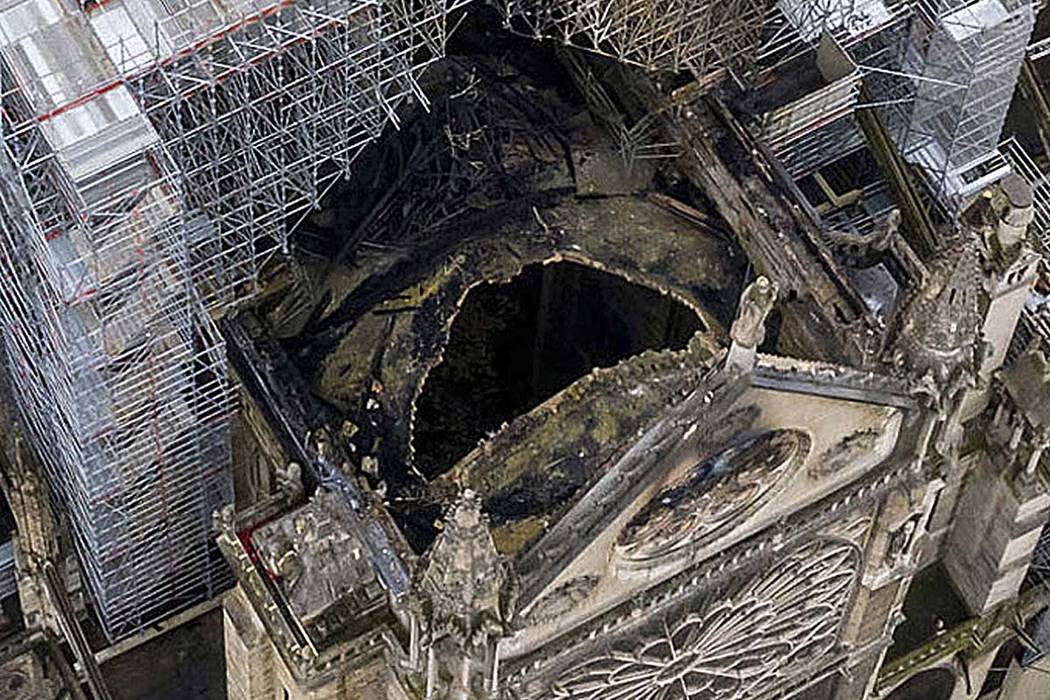Notre Dame fire due to electrical short-circuit, officials believe

PARIS — Paris police investigators think an electrical short-circuit most likely caused the fire at Notre Dame Cathedral, a police official said Thursday as France paid a daylong tribute to the firefighters who saved the world-renowned landmark.
A French judicial police official told The Associated Press that investigators made an initial assessment of the cathedral Wednesday but don’t have a green light to search Notre Dame’s charred interior because of ongoing safety hazards.
The official, who spoke on condition of anonymity because he wasn’t authorized to speak by name about an ongoing investigation, said the cathedral’s fragile walls were being shored up with wooden planks.
Earlier in the afternoon, French President Emmanuel Macron held a ceremony at the Elysee Palace to thank the hundreds of firefighters who battled the fast-moving for nine hours starting Monday evening. Authorities have said Notre Dame, which dates from the 12th century, was in danger of going up in flames before fire crews stopped it from spreading into a tower belfry.
Fire responders also rescued many of the important relics and works of art inside the cathedral.
“We’ve seen before our eyes the right things perfectly organized in a few moments, with responsibility, courage, solidarity and a meticulous organization”, Macron said. “The worst has been avoided.”
Macron said the firefighters will receive an Honor Medal for their courage and devotion.
As the ceremony took place, investigators continued seeking clues to what sparked the fire. The huge cathedral, including the spire that was consumed by flames and collapsed, was in the initial stages of a lengthy restoration.
Investigators so far believe the fire was accidental, and are questioning both cathedral staff and workers who were carrying out renovations. Some 40 people had been questioned by Thursday, according the Paris prosecutor’s office.
Unstable building
Fire officials warned that the building remains unstable and extremely dangerous, including for the construction workers who rushed to secure an area above one of the rose-shaped windows and other vulnerable sections of the fire-damaged structure.
Workers using a crane were removing some statues to lessen the weight on the cathedral’s fragile gables, or support walls, and to keep them from falling, since the section lacked the support of the massive timber roof that burned up in the devastating blaze.
Police, citing “important risks” of collapse and falling objects, officially closed Thursday a large swath of the island in the Seine River on which Notre Dame sits. The area had been unofficially blocked off since the fire.
Paris City Hall also was holding a ceremony in the firefighters’ honor Monday afternoon, with a Bach violin concert, two giant banners strung from the monumental city headquarters and readings from Victor Hugo’s “The Hunchback of Notre Dame.”
Remarkably, no one was killed in the fire, which began during a Mass, after firefighters and church officials speedily evacuated those inside.
Among the firefighters honored Thursday was Paris fire brigade chaplain Jean-Marc Fournier, who says he was falsely credited with helping salvage the crown of thorns believed to have been worn by Jesus at his crucifixion.
The chaplain said a team of rescuers broke the relic’s protective covering and an official who had the secret code to unlock the protection finished the job. Fournier told France Info on Thursday that his own team arrived on the heels of the salvaging and praised the action “to preserve this extraordinary relic, this patrimony of humanity.”
The building would have burned to the ground in a “chain-reaction collapse” had firefighters not moved as rapidly as they did to battle the blaze racing through the building, José Vaz de Matos, a fire expert with France’s Culture Ministry, said Wednesday.
Initial fire alert
An initial fire alert was sounded at 6:20 p.m., as a Mass was underway in the cathedral, but no fire was found. A second alarm went off at 6:43 p.m., and the blaze was discovered already consuming the roof.
Macron wants to rebuild the cathedral within five years — in time for the 2024 Summer Olympics that Paris is hosting — but experts say the vast scale of the work to be done could easily take 15 years, since it will take months, even years, just to figure out what should be done. Nearly $1 billion has been pledged for the cathedral’s restoration.
Benedicte Contamin, who came to view the damaged cathedral from afar Thursday, said she’s sad but grateful it’s still there.
“It’s a chance for France to bounce back, a chance to realize what unites us, because we have been too much divided over the past years,” she said.
Nicolas Vaux-Montagny and Angela Charlton in Paris contributed to this report.